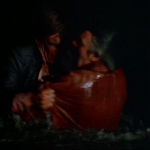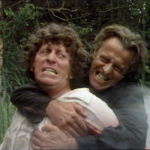by DAVID ROLINSON


Doctor Who: ‘The Deadly Assassin’ Part 3 vs. Play for Today: ‘Gangsters’
‘Scene v. Scene’ is a series of articles aiming to shed new light on key scenes from television dramas by comparing them with scenes from other programmes or films. This isn’t just about pointing out ‘influences’ or comparing styles or tagging intertextuality (although those things might happen sometimes), and also is a more bloggy, less academic approach than usual on this site – however, the case studies will be chosen to also raise wider issues about television drama. This is true of the case studies in this first article, two-aquatic punch-ups: the Doctor’s fight with Goth in part 3 of Doctor Who’s ‘The Deadly Assassin’ (BBC1, 13 November 1976) and Kline’s showdown with Rawlinson in the Play for Today (in effect series pilot) Gangsters (BBC1, 9 January 1975). They have a lot in common, both on- and off-screen.
Before we start, we should place the scenes in context: Kline is fighting a crime boss in the river Tame in Birmingham, near the end of a hard-hitting single play about multiculturalism, drugs, illegal immigration and, well, hard-hitting. The Doctor’s fight takes place in a wilderness contained within the virtual reality of ‘The Matrix’, a dreamscape accessed by linking brains to computers (yes, it would be too easy to compare it with The Matrix (1999)!) on Gallifrey. Both scenes are shot on film: Gangsters was all-film, Assassin typically for 1970s Doctor Who mixes studio video (here depicting Gallifrey) with filmed exteriors (here restricted to the scenes set in the Matrix), though part 3 has an unusually high number of filmed scenes. We’re not here to compare the styles of mid-1970s TV dramas, though that can be a rewarding and surprising process, especially given that directors and film cameramen (directors of photography) on contracts could be asked to move between very different types of drama. There are all sorts of reasons for similarities in the approaches of these two dramas, including the fact that the writers of both pieces – Robert Holmes (Assassin) and Philip Martin (Gangsters) – often riffed on Westerns and other genres: therefore, Doctor Who assimilated The Manchurian Candidate (1962) into teatime SF-horror while Gangsters took The French Connection (1971) into Birmingham clubland. We could compare these punch-ups with equivalents in various Westerns for instance – but the amount that these two scenes have in common says a lot about Doctor Who in 1976 and some of the pressures facing BBC drama.
